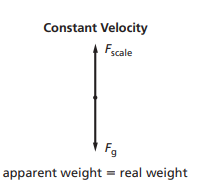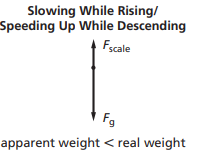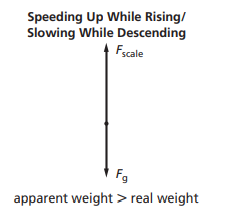
Concept explainers
The parts of the ride during which the real and apparent weights be the same.The parts of the ride during which the apparent weight is less than the real weight.The parts of the ride during which the apparent weight is more than the real weight. And to draw free body diagrams.
Explanation of Solution
Introduction:
The weight of an object changes in lift depending upon direction of motion of the lift, this weight is called apparent weight.
The apparent weight and real weight will be same when the lift is going upward or downward with constant velocity.
The below free body diagram shows the case when apparent weight is same as the real weight.

Figure-(1)
Apparent weight will be less than the real weight when the lift is going downward with increasing or decreasing speed.
The free body diagram below shows the case when apparent weight is less than the real weight.

Figure-(2)
Apparent weight will be more than the real weight if the lift is going upward with increasing or decreasing speed.
The free body diagram below shows the case when apparent weight is greater than the real weight.

Figure-(3)
Conclusion:
Therefore, the apparent weigh is same as real weight when the elevator is moving with constant velocity, less when elevator is going downward with variable speed and greater if elevator is going upward with variable velocity the free body diagrams are shown above.
Chapter 4 Solutions
Glencoe Physics: Principles and Problems, Student Edition
Additional Science Textbook Solutions
Microbiology: An Introduction
Genetic Analysis: An Integrated Approach (3rd Edition)
Campbell Biology (11th Edition)
Organic Chemistry (8th Edition)
Anatomy & Physiology (6th Edition)
Applications and Investigations in Earth Science (9th Edition)
- 4.46 The two blocks in Fig. P4.46 are connected by a heavy uniform rope with a mass of 4.00 kg. An up- ward force of 200 N is applied as shown. (a) Draw three free-body diagrams: one for the 6.00 kg block, one for B the 4.00 kg rope, and another one for the 5.00 kg block. For each force, indicate what object exerts that force. (b) What is the acceleration of the system? (c) What is the tension at the top of the heavy rope? (d) What is the tension at the midpoint of the rope? Figure P4.46 F= 200 N 4.00 kg 6.00 kg 5.00 kgarrow_forward4.35 ⚫ Two adults and a child want to push a wheeled cart in the direc- tion marked x in Fig. P4.35 (next page). The two adults push with hori- zontal forces F and F as shown. (a) Find the magnitude and direction of the smallest force that the child should exert. Ignore the effects of friction. (b) If the child exerts the minimum force found in part (a), the cart ac- celerates at 2.0 m/s² in the +x-direction. What is the weight of the cart? Figure P4.35 F₁ = 100 N 60° 30° F2 = 140 Narrow_forward4.21 ⚫ BIO World-class sprinters can accelerate out of the starting blocks with an acceleration that is nearly horizontal and has magnitude 15 m/s². How much horizontal force must a 55 kg sprinter exert on the starting blocks to produce this acceleration? Which object exerts the force that propels the sprinter: the blocks or the sprinter herself?arrow_forward
- No chatgpt pls will upvotearrow_forwardPlease don't use Chatgpt will upvote and give handwritten solutionarrow_forwardThe kinetic energy of a pendulum is greatest Question 20Select one: a. at the top of its swing. b. when its potential energy is greatest. c. at the bottom of its swing. d. when its total energy is greatest.arrow_forward
- Part a-D plarrow_forwardThe figure (Figure 1) shows representations of six thermodynamic states of the same ideal gas sample. Figure 1 of 1 Part A ■Review | Constants Rank the states on the basis of the pressure of the gas sample at each state. Rank pressure from highest to lowest. To rank items as equivalent, overlap them. ▸ View Available Hint(s) highest 0 ☐ ☐ ☐ ☐ ☐ ☐ Reset Help B F A D E The correct ranking cannot be determined. Submit Previous Answers × Incorrect; Try Again; 4 attempts remaining Provide Feedback lowest Next >arrow_forwardPart A m 2πkT ) 3/2 Calculate the integral (v) = f vƒ (v)dv. The function f(v) describing the actual distribution of molecular speeds is called the Maxwell-Boltzmann distribution, = ƒ(v) = 4π (· v²e-mv²/2kT . (Hint: Make the change of variable v² =x and use the tabulated integral foxne integer and a is a positive constant.) Express your answer in terms of the variables T, m, and appropriate constants. -ax dx n! - an+1 where n is a positive (v) = ΕΠΙ ΑΣΦ Submit Previous Answers Request Answer ? × Incorrect; Try Again; 4 attempts remaining Al Study Tools Looking for some guidance? Let's work through a few related practice questions before you go back to the real thing. This won't impact your score, so stop at anytime and ask for clarification whenever you need it. Ready to give it a try? Startarrow_forward
- Starter the rule of significantarrow_forwardPlease solve this problem and give step by step explanations on each step while breaking it down please. Thank you!!arrow_forwardPlease solve this problem and give step by step explanations on each step while breaking it down please. Thank you!!arrow_forward
 College PhysicsPhysicsISBN:9781305952300Author:Raymond A. Serway, Chris VuillePublisher:Cengage Learning
College PhysicsPhysicsISBN:9781305952300Author:Raymond A. Serway, Chris VuillePublisher:Cengage Learning University Physics (14th Edition)PhysicsISBN:9780133969290Author:Hugh D. Young, Roger A. FreedmanPublisher:PEARSON
University Physics (14th Edition)PhysicsISBN:9780133969290Author:Hugh D. Young, Roger A. FreedmanPublisher:PEARSON Introduction To Quantum MechanicsPhysicsISBN:9781107189638Author:Griffiths, David J., Schroeter, Darrell F.Publisher:Cambridge University Press
Introduction To Quantum MechanicsPhysicsISBN:9781107189638Author:Griffiths, David J., Schroeter, Darrell F.Publisher:Cambridge University Press Physics for Scientists and EngineersPhysicsISBN:9781337553278Author:Raymond A. Serway, John W. JewettPublisher:Cengage Learning
Physics for Scientists and EngineersPhysicsISBN:9781337553278Author:Raymond A. Serway, John W. JewettPublisher:Cengage Learning Lecture- Tutorials for Introductory AstronomyPhysicsISBN:9780321820464Author:Edward E. Prather, Tim P. Slater, Jeff P. Adams, Gina BrissendenPublisher:Addison-Wesley
Lecture- Tutorials for Introductory AstronomyPhysicsISBN:9780321820464Author:Edward E. Prather, Tim P. Slater, Jeff P. Adams, Gina BrissendenPublisher:Addison-Wesley College Physics: A Strategic Approach (4th Editio...PhysicsISBN:9780134609034Author:Randall D. Knight (Professor Emeritus), Brian Jones, Stuart FieldPublisher:PEARSON
College Physics: A Strategic Approach (4th Editio...PhysicsISBN:9780134609034Author:Randall D. Knight (Professor Emeritus), Brian Jones, Stuart FieldPublisher:PEARSON





